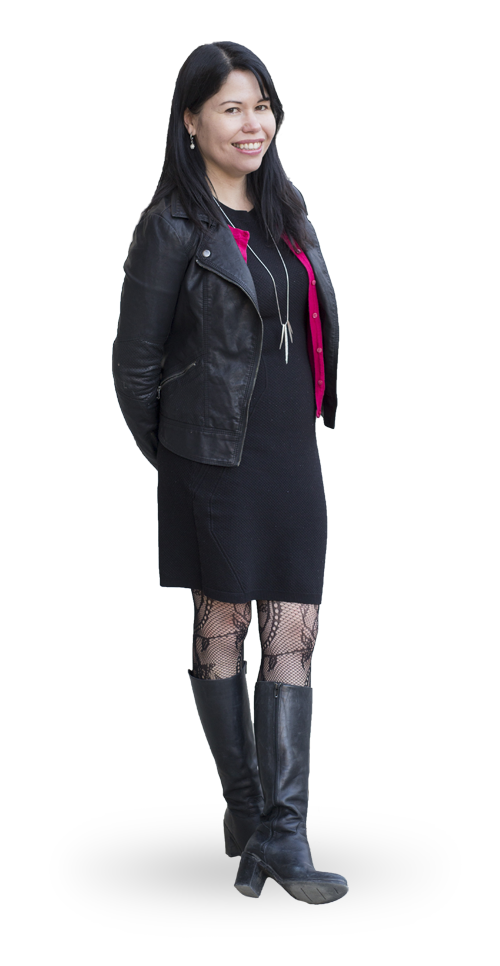Dawn Dumont (BA’95) has come a long way since her days as a silent face at the back of a U of S classroom. She is now a comedian, playwright and the author of two books. Her regular columns in Eagle Feather News and The Saskatoon StarPhoenix assert her views on topics including the law, social justice and how to chase out unwanted guests with a pail of burnt cabbage. Here she reveals what inspired her to change and what’s different for young Aboriginal women today.
I FOLLOW SEVERAL young, outspoken Indigenous females on social media. As inspiring as they are, they also scare the crap out of me—what if someone punishes them for being so outspoken?
But at all times, I am in awe of their direct honesty. When I was their age, I was one of those shadow university students who sat in the corner of the class and never spoke. I wanted to. I would sit through the class psyching myself up but then my brain would ask the big three: “Are there any cute boys in class today?”, “Is this the most brilliant thing that anyone has ever said in the world?” and most importantly, “Is there something on my face?” I never found the perfect moment to speak, as there usually was something on my face.
There were many times that I wished I’d spoken up: in the business ethics class when most of the students said that they would cover up a company chemical spill in a third world country rather than risk their job. If I’d had the power of speech, I would have said, “Are you freaking nuts?” Or in the history class when a middle-aged white student said, “Most of the bad stuff done to the Natives was done by the Spanish, because they’re so hot-blooded.” To her chagrin, an actual student from Spain glared at her and said, “I’m feeling pretty hot-blooded right now.”
Although there’s not much I could have added to that interaction except perhaps, “Hey, calm down: you were both jerks.”
It was perhaps a good thing that I was in the habit of keeping my mouth shut; many of my beliefs were bonkers. The media told me that Native people were poor, addicted and drains on Canadian society. Neither the media nor the Saskatchewan education system provided any context for the social problems, so I came to the conclusion Indigenous people were just inherently messed up.
Take addiction—I theorized that this was a biological weakness. If some groups had blue eyes and blond hair, then other groups could have brown eyes and livers that gulped down booze. In the Aboriginal Student Centre I shared my theory with an older Native student and he just smiled wearily at me: “You poor kid, you don’t know anything about residential schools, do you?”
Not once in my 12 years of education in the Saskatchewan school system had Canada’s history of colonialism been addressed. There was a memorable presentation in Grade Two about the torture that the Mohawk inflicted on Father Brébeuf—complete with an audio recording of Father Brébeuf screaming through the night (an actor, I assume). And from time to time, the names of famous chiefs were brought up, but there was no link showing how we got from then to now: from buffalo hunters and treaty-makers to people eking out an existence on the reserve.

After I graduated from university, I started writing plays and got to work with Indigenous actors. They bounced across the stage, filling up theatres with their fearless voices. I wished I could be alive like them. Start doing stand-up, they told me.
And so I did. Well, not exactly. I circled the idea of being a stand-up comic for a year. I went to comedy events every night of the week until I got the courage to go onstage. I had no idea how unique I was. On any given comedy night, out of 30 comedians, only five would be females. And out of those women, I was the only Indigenous one. But I didn’t see that; I only saw that my legs shook like Jell-O when I looked out at the crowd.
I probably would have stopped if weren’t for the bullying of another comic. He was a host of a comedy open mic near where I lived, a young white guy (what are the odds?). Every Sunday, I would go to his show and say, “I’d like a spot.” Then fifteen minutes later, I’d change my mind: “Cancel it, I’m feeling sick.” But he would just smile and tell me, “You’re going on.”
Being bullied by a white guy is never good—except in this case (or perhaps in a Christian Grey scenario). Because without his insistence, I would have chickened out again and again. And I would have stayed in the shadows, too careful to speak.
I learned to speak late in life, which is a shame. But maybe it was just in time to join the chorus of other Indigenous women pronouncing our frustrations, our accomplishments and aspirations, despite our fear that we will be punished, silenced or that there might be something on our faces.